|
Although it’s a trifle early to sow many seeds, sweet peas do well sown in cooler conditions because they develop better root systems. And, as any gardener will tell you, sweet peas are essentials. Their frilled flowers, which pack a powerful scent, epitomise a soft summer’s day and if you pick them you encourage more. Nothing enriches a summer’s day more than a simple jug or jar of these wavy creations on a table. And they’re simple to grow, whether you sow seeds or buy ready-grown plants. You’ll have bunches to give away to friends, neighbours and family whether it’s a tripod in a flower bed, a container-full by the door or traditional rows in a cutting garden. They’ll make the first half of summer sweeter.
From Seed

If you’re starting from seed you’ll need a bright position that offers cool temperatures so a coldframe, a cool greenhouse or a west-facing windowsill is ideal. You’re trying to avoid fluctuations in temperatures, between over-warm days and cold nights, because sweet peas make stronger plants if they encounter cooler conditions of 10 - 15C. If you’re wanting to grow lots, a small coldframe produces the best plants although potfuls are vulnerable to attacks from mice and slugs can attack the shoots as the seeds germinate.
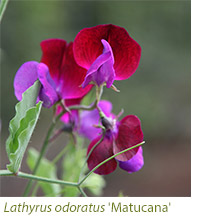 When it comes to compost these large seeds, which are perfect for children to handle, do well in John Innes No.1 and it’s possible to use clean, small 9cm plastic pots and raise several seedlings, say 5 -7 seeds, in the same pot. Half fill the pot with compost and give the compost a good water at this stage, so that there is moisture in the bottom of the pot, for these cool customers rely on moist soil. Then almost fill the pots up to within half of an inch of the tops and press the seeds down gently so that they lie about half to three quarters of an inch below the surface (1 -2 cm). Cover the seeds with compost and water once again, lightly this time, and cover the pots with polythene - a bag per pot will do the trick. This will speed up germination and after 5 -7 days the seeds should begin to peek through. The polythene must be removed as soon as the tips appear. Once your plants are developing their true leaves pinch out the tops so the plants bush out. They should be ready to put outside between mid-April and mid-May. When it comes to compost these large seeds, which are perfect for children to handle, do well in John Innes No.1 and it’s possible to use clean, small 9cm plastic pots and raise several seedlings, say 5 -7 seeds, in the same pot. Half fill the pot with compost and give the compost a good water at this stage, so that there is moisture in the bottom of the pot, for these cool customers rely on moist soil. Then almost fill the pots up to within half of an inch of the tops and press the seeds down gently so that they lie about half to three quarters of an inch below the surface (1 -2 cm). Cover the seeds with compost and water once again, lightly this time, and cover the pots with polythene - a bag per pot will do the trick. This will speed up germination and after 5 -7 days the seeds should begin to peek through. The polythene must be removed as soon as the tips appear. Once your plants are developing their true leaves pinch out the tops so the plants bush out. They should be ready to put outside between mid-April and mid-May.
Sweet peas do not need extra food because they’re legumes, or members of the pea family. They fix nitrogen by producing root nodules. However they do like a bright position and deep, friable soil that’s been well dug so it will pay dividends to prepare the ground well.
 Sweet peas also need supports and they twine using fine tendrils. Twiggy pea sticks are ideal and should be put into the ground before planting, or you can use canes and string and clip the plants to them using special sweet pea support rings.When planting out, tease the potful apart very gently and, using a trowel, plant them singly and then make sure that if it’s a dry spring you water them during the day. Sweet pea plants are also sold in root trainers and this is a very good method if you want to do a large potful or a single tripod. Sweet peas also need supports and they twine using fine tendrils. Twiggy pea sticks are ideal and should be put into the ground before planting, or you can use canes and string and clip the plants to them using special sweet pea support rings.When planting out, tease the potful apart very gently and, using a trowel, plant them singly and then make sure that if it’s a dry spring you water them during the day. Sweet pea plants are also sold in root trainers and this is a very good method if you want to do a large potful or a single tripod.
If you like understated sweet peas with smaller flowers ‘Cupani’ is an historic variety sent here in 1699 by a Sicilian monk called Francis Cupani. The seeds of this wine-red and purple sweet pea were sent to Dr Robert Uvedale, a teacher from Enfield, Middlesex. Uvedale, a master at Enfield Grammar School, was one of the first to have a hothouse and he swapped plants and by 1724 the pink and white ‘Painted Lady’ was being grown. These heritage varieties, with smaller flowers, bear lots of scented flowers.

‘Cupani’s Original’ was named more recently after wild collected seeds were gathered by New Zealand sweet pea expert Keith Hammett in Sicily in the 1970s. Keith, a world renowned sweet pea breeder, raised ‘High Scent’, a white with a violet flush that’s considered the benchmark variety for scent.
Other highly scented, robust varieties include ‘Gwendoline’, a very wavy rose-pink and white sweet pea that seems to flower forever and ever. If you haven’t grown sweet peas before, this one will do well for you. It was raised by Unwins in 1999. Unwins also raised a really good dark blue named ‘Oxford Blue’ in 2001 and this sweet pea produces long stems and it’s a very robust variety as well as being a unique colour.
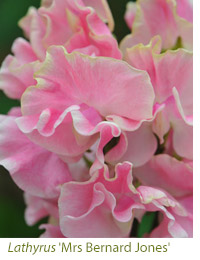 ‘Mrs Bernard Jones’ is another excellent variety, with sugar pink falls that gradually whiten. The flowers are large and it’s extremely scented. The raiser, Bernard Jones, named it for his wife in 1994, but in the late 1960s I received a wonderful bunch of sweet peas from Mr Jones who was the pharmacist at Leamington Hospital. The salmon-cream ‘Bobby’s Girl’ is a newer variety that’s very willing to produce flowers and if you’re growing a warm salmon-tinted colour with a soft pink, always use a dark red variety for contrast such as ‘Beaujolais’. Or add a touch of cool colour with the lavender-pink ‘Daphne’, or the pure pale blue ‘Charlie’s Angel’. ‘Royal Wedding’, named in 1982, is an exceptional clear white that’s softened by a hint of cream and pink and it’s able to produce long stemmed flowers so this is a good one for the cutting garden. ‘Mrs Bernard Jones’ is another excellent variety, with sugar pink falls that gradually whiten. The flowers are large and it’s extremely scented. The raiser, Bernard Jones, named it for his wife in 1994, but in the late 1960s I received a wonderful bunch of sweet peas from Mr Jones who was the pharmacist at Leamington Hospital. The salmon-cream ‘Bobby’s Girl’ is a newer variety that’s very willing to produce flowers and if you’re growing a warm salmon-tinted colour with a soft pink, always use a dark red variety for contrast such as ‘Beaujolais’. Or add a touch of cool colour with the lavender-pink ‘Daphne’, or the pure pale blue ‘Charlie’s Angel’. ‘Royal Wedding’, named in 1982, is an exceptional clear white that’s softened by a hint of cream and pink and it’s able to produce long stemmed flowers so this is a good one for the cutting garden.
 Sweet Peas celebrate high summer, but there are also perennial peas that produce non-scented flowers in August. These cut very well, with a herringbone of flowers, and they come up year after year. Their flowers are adored by butterflies and L. latifolius ‘White Pearl’ is glorious in semi-shade, or you could try to the blush pink ‘Rosa Perle’. These everlasting peas, as they’re sometimes known, are very good in poor soil and hot spots. Or they will twine from shadier positions into sunny ones, making substantial plants. Do remove the seed heads though, because they can be a little too good at self seeding. Sweet Peas celebrate high summer, but there are also perennial peas that produce non-scented flowers in August. These cut very well, with a herringbone of flowers, and they come up year after year. Their flowers are adored by butterflies and L. latifolius ‘White Pearl’ is glorious in semi-shade, or you could try to the blush pink ‘Rosa Perle’. These everlasting peas, as they’re sometimes known, are very good in poor soil and hot spots. Or they will twine from shadier positions into sunny ones, making substantial plants. Do remove the seed heads though, because they can be a little too good at self seeding.
|
Things to do
 |
Track Down the Gastropods
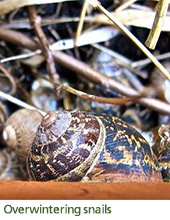
Most slugs only last for a year, but their eggs overwinter. Hoeing and turning over the soil now will expose these eggs and allow them to be predated by birds, beetles and other creatures. Snails overwinter in clusters as adults. Frisk inside large containers and in nooks and crannies and destroy any clusters that you find.
|
 |
Make Sure You Get Your Seed Potatoes
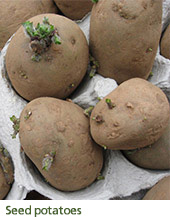
This is the last opportunity to get seed potatoes. Early varieties should be allowed to chit in a cool, light place - ie. produce shoots. Then they will crop a little earlier. Main crops do not need to be chitted. Good early varieties include ‘Casablanca’ and 'Duke of York' and these will be ready from the end of June onwards if planted in early April. ‘Maris Piper’ is an early main crop well worth growing because it’s tasty and cooks so well. Harvest it in September.
|
 |
Stock Up

Check out the sundries, labels, string, pens, markers, supports etc and stock up now.
|
 |
Write Labels
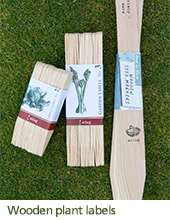
It’s too early for sowing most seeds, but you can get on with writing labels because this will save time later when it’s bound to be frantic.
|
 |
Tidy Up

Late-season perennials and grasses should be cut down now. Put them on the compost heap, or pile them up in the garden, because lots of creatures are sure to be hibernating in the stems and nooks and crannies. Definitely don’t burn them!
|
|
|
|















